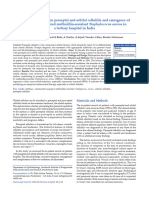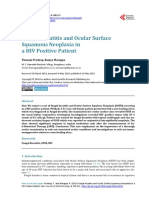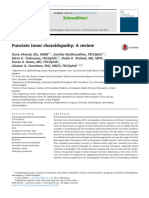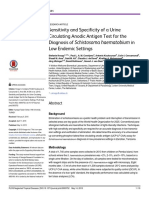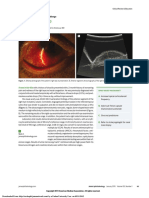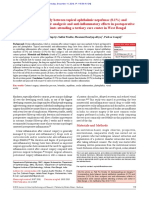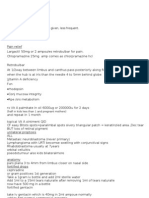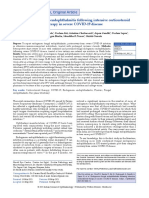Professional Documents
Culture Documents
Clinical Profile of Tubercular Uveitis in A Tertiary Care Ophthalmic Centre
Clinical Profile of Tubercular Uveitis in A Tertiary Care Ophthalmic Centre
Uploaded by
Arif BudimanOriginal Description:
Original Title
Copyright
Available Formats
Share this document
Did you find this document useful?
Is this content inappropriate?
Report this DocumentCopyright:
Available Formats
Clinical Profile of Tubercular Uveitis in A Tertiary Care Ophthalmic Centre
Clinical Profile of Tubercular Uveitis in A Tertiary Care Ophthalmic Centre
Uploaded by
Arif BudimanCopyright:
Available Formats
33 BEST OF BEST PAPERS OF ALL SESSIONS
T
uberculosis is a communicable disease
caused by Mycobacterium tuberculosis or
related members of the TB complex. About 10%
of infected individuals become symptomatic of
which 1-2% present as uveitis. 90% remain
infected for the rest of their lives without
manifesting the disease.
2
Though ocular
tuberculosis is rare, incidence of pulmonary and
extrapulmonary TB has increased - in part
because of the rapid spread of AIDS.
3
Ocular TB
is defined as an infection by M. tuberculosis in
the eye, around the eye, or on its surface.
2
Classically it has been divided into two types
based on its pathogenesis: primary and
secondary. Primary disease implies that the eye
is the initial port of entry while in secondary
disease the organisms spread to the eye
hematogenously. Primary disease includes
conjunctival, corneal, and scleral disease, while
tuberculous uveitis is a common manifestation of
secondary disease.
4
The TB bacillus is highly
aerobic, with an affinity for oxygenated tissues.
Thus, tuberculosis frequently affects apices of
lungs as well as the choroids, which has the
highest blood flow rate in the body. The most
common clinical findings of intraocular TB
include solitary or multiple choroidal nodules,
choroiditis and retinal vasculitis.
5,8-10
The
choroidal nodules suggest direct hematogenous
infection while vasculitis and choroiditis are
more likely to be result of immune
hypersensitivity. Tuberculous anterior uveitis is
typically granulomatous and accompanying
vitritis is not uncommon.
2
TB should be
considered in differential diagnosis of chronic
anterior granulomatous uveitis with or without
posterior segment involvement. Absence of
clinically evident pulmonary TB does not rule out
the possibility of ocular TB, as 60% of patients
with extra pulmonary TB have no evidence of
pulmonary tuberculosis.
6
To analyse the clinical profile, treatment and
visual outcome in patients with evidence of
systemic tuberculosis and uveitis suspected as
tubercular uveitis presenting with varied ocular
manifestations in a tertiary eye care centre
between January 2007 and December 2007.
Materials and Methods
This was a retrospective, non-comparative,
interventional type study. 45 eyes of 27 patients
were analysed. The patients were presumed to
have tuberculous uveitis if they fulfilled one of
the following criteria:
1. uveitis with prior documented history of
systemic tuberculosis.
2. uveitis with corroborative evidence of
systemic disease with positive Mantoux skin
test and chest radiograph.
3. PCR analysis for M. tuberculosis from
aqueous or vitreous sample.
4. Positive Quantiferon gold test for M.
tuberculosis.
5. FNAC from hilar or cervical lymphnode
positive for cytology.
A detailed history was elicited and a complete
ocular examination was conducted for all
patients. The following demographic and
AUTHORSS PROFILE:
DR. JYOTIRMAY BISWAS: M.S., PGIMER, Chandigarh; Fellow, VR
Surgery, Sankara Nethralaya, Chennai; Fellow, Ophthalmic Pathology,
Doheny Eye Institute, Southern California, USA. Presently Director,
Dept. of Uveitis and Head, Dept. of Ophthalmic Pathology, Sankara
Nethralaya, Chennai.
This paper was conferred with the NARSING A RAO Award for the BEST PAPER of UVEA Session.
Clinical Profile of Tubercular Uveitis in A Tertiary Care
Ophthalmic Centre
Dr. Jyotirmay Biswas, Dr. Renu Athanikar, Dr. Sudharshan. S., Miss. Kaleemannisha
(Presenting Author: Dr. Renu Athanikar)
BEST PAPER
OF
UVEA
SESSION
medical data was recorded : patient age, gender,
medical history, laterality of disease, initial visual
acuity, ocular findings like anterior segment
flare, cells, keratic precipitates, synaechiae,
associated vitritis if present, morphologic
description of choroidal lesions and additional
features if any. Chest X-ray and Mantoux test
were done in all patients. USG B scan showing
choroidal mass was done in 16 eyes. Aqueous tap
was done in 8 eyes. Vitreous tap was done in 4
eyes. FNAC was done in 1 patient. Quantiferon
gold test was done in 1 patient. All patients were
treated with anti tuberculous treatment and
steroids (topical/periocular/systemic). Patients
were followed up regularly upto a period of 1
year and treatment response was assessed based
on visual acuity and status of anterior and
posterior segment inflammation.
Results
45 eyes of 27 patients were analysed. Age range
was 7 to 62 years, mean age of presentation being
32.3 years. Presentation was bilateral in 18
(66.66%) patients and unilateral in 9 (33.33%)
patients. 9 (33.33%) patients had prior
documented history of systemic tuberculosis
while 18 (66.67%) patients had no previous
history of tuberculosis. Clinical presentations
included: choroidal granuloma in 22 eyes (48.88
%), intermediate uveitis in 9 eyes (20%),
granulomatous anterior uveitis in 6 eyes
(13.33%), panuveitis in 3 eyes (6.7%), multifocal
choroiditis in 4 eyes (8.9%) and serpiginous like
choroiditis in 1 eye (2.2%). Chest X-ray and
Mantoux test were done in all patients while
polymerase chain reaction (PCR) on
aqueous/vitreous samples, fine needle aspiration
cytology (FNAC), Quantiferon gold test were
done in selected patients. Most common
modality of treatment was a combination of anti
tuberculosis treatment (ATT) and steroids
(topical/periocular/oral). Vision improved in 60
% in eyes, remained stable in 13.33% eyes and
deteriorated in 26.66 % eyes.
Discussion
Ocular tuberculosis presents a complex clinical
problemdue to a wide spectrumof presentations
and difficulty in diagnosis.
5,6,7
Uveitis is the most
common ocular manifestation and can present as
anterior, posterior, or panuveitis
1
of which the
most common is choroiditis as shown in a study
by Nagini Sarvananthan et al.
12
But our study
revealed choroidal granuloma as the commonest
presentation. Samson MC
1
et al reported that
tubercular anterior uveitis is typically
granulomatous and may occur with or without
posterior segment involvement which coincides
with our study. Tuberculous uveitis has varied
presentations such as choroidal granuloma,
intermediate uveitis, granulomatous anterior
uveitis, panuveitis, multifocal choroiditis and
serpiginous like choroiditis as seen in our study.
Thus a high index of suspicion should be present
to pick up TB uveitis and prompt treatment with
anti tuberculous drugs should be started. Gupta
et al
13
reported a series of seven cases with
serpiginous like choroiditis. All seven cases had
fundus features suggestive of this condition but
continued to progress in spite of adequate steroid
treatment and subsequently responded to ATT.
Our study showed 1 such presentation.
The diagnosis of tuberculosis is frequently
presumptive.
2
Definitive diagnosis is by
demonstration of tubercle bacilli in tissue
obtained by biopsy. In our study FNAC was
done in 1 patient which gave positive result. But
ocular manifestations may result from a delayed
hypersensitivity reaction in absence of any
infectious agent.
7
Thus evaluating presence of
systemic disease is of prime importance.
Mantoux skin test is the standard test for
diagnosis of systemic TB.
7
A positive skin test is
detectable 3 to 8 weeks after primary infection.
An intense skin reaction is an immunologic
response based on delayed hypersensitivity.
There is no specific size of induration that
confirms TB, nor does a negative test exclude
diagnosis of TB.
7
Thus the results of Mantoux test
need to be interpreted keeping in mind previous
BCG vaccination, exposure to nontuberculous
mycobacteria and systemic immunosuppression
or malnutrition. In cases of diagnostic dilemma
PCR for ocular fluid can be done. It is a rapid test
with a high sensitivity and specificity.
4
It is more
useful because only a small sample is needed and
viable cells are not required.
4
In our study PCR
testing of aqueous was done in 8 eyes of which 4
showed positive result. PCR testing of vitreous
sample was done in 4 eyes of which 2 showed
positive result. Newer tests such as Quantiferon
TB gold test are based on gamma interferon
production by T cells sensitized to specific
34 AIOC 2009 PROCEEDINGS
antigens, which are specific to M. tuberculosis
and therefore not influenced by BCG or most
nontuberculous bacteria. In our study 1 patient
was subjected to this test to confirm diagnosis of
TB.
Response to treatment is mainly monitored by
bacteriological evaluation. Patients with
pulmonary TB should get their sputum
examination done monthly till cultures turn
negative. In case of ocular TB the response to
treatment must be assessed clinically. Response
usually occurs within first 2 weeks. Patients on
ATT should also be educated and monitored for
drug toxicity. LFT should be done regularly and
medicines should be discontinued if there are
signs of drug induced hepatitis. Optic neuritis
may occur with ethambutol and eighth nerve
damage may occur with streptomycin.
Hypersensitivity reactions may also occur and
may need discontinuation of therapy. Acute
uveitis has been reported with rifampin.
11
1. Tubercular uveitis has protean
manifestations.
2. A high index of suspicion helps in early
diagnosis of TB uveitis.
3. Mantoux test remains a standard test to
diagnose ocular tuberculosis.
4. In case of diagnostic dilemma, PCR testing of
intraocular fluid can help in diagnosis.
5. Newer tests like quantiferon can be very
supportive and have increased the diagnostic
yield.
6. ATT in addition to topical/periocular/
systemic steroids remains as a mainstay of
treatment.
7. Improvement of ocular condition is based on
early recognition and appropriate
management of systemic condition.
35 BEST OF BEST PAPERS OF ALL SESSIONS
References
1. Samson MC, Foster CS. Tuberculosis. In:
Foster CS, Vitale AT (eds). Diagnosis and
treatment of Uveitis. WB Saunders Company:
Philadelphia, 2002; p 264-72.
2. Varma D, Anand S, Reddy AR, Das A,
Watson JP, Currie DC, Sutcliffe I, Backhouse
OC. Tuberculosis : an under-diagnosed
aetiological agent in uveitis with an effective
treatment. Eye. 2006;20:1068-73.
3. Panuveitis: in American Academy of
Ophthalmology: Section 9-Intraocular
inflammation and uveitis 2005-2006;193.
4. Sheu SJ, Shyu JS, Chen LM, Chen YY, Chirn
SC, Wang JS. Ocular manifestations of
tuberculosis. Ophthalmology 2001;108:1580-5.
5. Biswas J, Madhavan HN, Gopal L, Badrinath
SS. Intraocular tuberculosis. Clinicopatho-
logic study of five cases. Retina 1995;15:461-8
Review.
6. Alvarez S, McCabe WR. Extrapulmonary
tuberculosis revisited: A review of experience at
Boston City and other hospitals. (Baltimore)
1984;63:25-55.
7. Bodaghi B, LeHoang P. Ocular tuberculosis
(review) Curr Opin Ophthalmol 2000;11:443-8.
8. Rosen P H,Spalton DJ, Graham E
M.Intraocular tuberculosis. Eye 1990:4:486-92.
9. Ishihara M,Ohno S (Ocular tuberculosis).
Nippon Rinsho 1998:56:3157-61.
10. Cangemi FE,Friedman A H,Josephberg
R.Tuberculoma of the choroids
Ophthalomology 1980;87:252-8.
11. Spindler E, Deplus S, Flageul B.Uveites aigues
au cours des reactions de reversion. Acta
Leprol 1991;7:331-4.
12. Nagini S, Martin W, Kim B:intraocular
tuberculosis without detectable systemic
infection: Arch Ophthalmol 1998:116;1386-8.
13. Vishali Gupta, Amod Gupta, Sunil A,
Pradeep B, Mangat D, Anita A. Presumed
tubercular serpiginous like choroiditis:
Ophthalmology 2003;110:1744-9.
You might also like
- ICD 10 - Chapter 7 Diseases of The Eye, AdnexaDocument7 pagesICD 10 - Chapter 7 Diseases of The Eye, AdnexaAhmad Musa SimbolonNo ratings yet
- The Red EyeDocument71 pagesThe Red Eyehenok biruk80% (5)
- Eye Care in Developing NationsDocument273 pagesEye Care in Developing NationsNirav Sharma100% (1)
- Aravind FAQs in Ophthalmology - 1 PDFDocument708 pagesAravind FAQs in Ophthalmology - 1 PDFMilthon Catacora ContrerasNo ratings yet
- A Case Series of Ocular Manifestations in TuberculosisDocument4 pagesA Case Series of Ocular Manifestations in TuberculosisInternational Journal of Innovative Science and Research TechnologyNo ratings yet
- Mode of Presentation TBDocument7 pagesMode of Presentation TBSohaib Abbas MalikNo ratings yet
- International Journal of Infectious Diseases: A.G. Vos, M.W.M. Wassenberg, J. de Hoog, J.J. OosterheertDocument7 pagesInternational Journal of Infectious Diseases: A.G. Vos, M.W.M. Wassenberg, J. de Hoog, J.J. OosterheertSohaib Abbas MalikNo ratings yet
- Tubercular ScleritisDocument5 pagesTubercular Scleritismutya yulindaNo ratings yet
- 2014 Article 33Document5 pages2014 Article 33SusPa NarahaNo ratings yet
- Primary Conjunctival Tuberculosis-2Document3 pagesPrimary Conjunctival Tuberculosis-2puutieNo ratings yet
- TranslateDocument5 pagesTranslatenoviadewaniNo ratings yet
- Uveitis in Children and Adolescents: Extended ReportDocument5 pagesUveitis in Children and Adolescents: Extended ReportSelfima PratiwiNo ratings yet
- Analysis of The Clinical Diagnosis and Treatment of UveitisDocument7 pagesAnalysis of The Clinical Diagnosis and Treatment of UveitisRhysandNo ratings yet
- Case Report: Tuberculous Scleritis A Challenging DiagnosticDocument10 pagesCase Report: Tuberculous Scleritis A Challenging DiagnosticIJAR JOURNALNo ratings yet
- Pi Is 1201971213002142Document5 pagesPi Is 1201971213002142melisaberlianNo ratings yet
- Ijpedi2021 1544553Document6 pagesIjpedi2021 1544553Naresh ReddyNo ratings yet
- 9 Samuel EtalDocument4 pages9 Samuel EtaleditorijmrhsNo ratings yet
- Controversies in Ocular Tuberculosis: Marcus Ang, Soon-Phaik CheeDocument4 pagesControversies in Ocular Tuberculosis: Marcus Ang, Soon-Phaik CheeLucas HoldereggerNo ratings yet
- CE Update: Wegener's Granulomatosis: A Review of The Clinical Implications, Diagnosis, and TreatmentDocument3 pagesCE Update: Wegener's Granulomatosis: A Review of The Clinical Implications, Diagnosis, and TreatmentAfif FaiziNo ratings yet
- BR J Ophthalmol 2005 BenEzra 444 8Document6 pagesBR J Ophthalmol 2005 BenEzra 444 8Gemilang KhusnurrokhmanNo ratings yet
- Ni Hms 820468Document41 pagesNi Hms 820468Sohaib Abbas MalikNo ratings yet
- Invasive Sino-Aspergillosis in ImmunocompetentDocument5 pagesInvasive Sino-Aspergillosis in Immunocompetentabeer alrofaeyNo ratings yet
- Iaet 12 I 2 P 135Document2 pagesIaet 12 I 2 P 135leonjunchan_66965707No ratings yet
- 2016 Article 294 PDFDocument7 pages2016 Article 294 PDFChato Haviz DanayomiNo ratings yet
- H Pylori Ricci2007 PDFDocument15 pagesH Pylori Ricci2007 PDFHasbiallah YusufNo ratings yet
- Fungal Keratitis and Ocular Surface Squamous Neoplasia in A HIV Positive PatientDocument4 pagesFungal Keratitis and Ocular Surface Squamous Neoplasia in A HIV Positive PatientSherly AsrianiNo ratings yet
- Unusual Etiology of UTIDocument22 pagesUnusual Etiology of UTIkidsnephrotipsNo ratings yet
- 1 s2.0 S003962571630090X MainDocument14 pages1 s2.0 S003962571630090X MainBenjamin NgNo ratings yet
- Clinico-Epidemiological Profile of Childhood Cutaneous TuberculosisDocument7 pagesClinico-Epidemiological Profile of Childhood Cutaneous TuberculosisFajar SatriaNo ratings yet
- Blau Int ReviewDocument9 pagesBlau Int ReviewAslıhan Yılmaz ÇebiNo ratings yet
- Acute Focal Bacterial Nephritis, Pyonephrosis and Renal Abscess in ChildrenDocument7 pagesAcute Focal Bacterial Nephritis, Pyonephrosis and Renal Abscess in ChildrenSAhand HamzaNo ratings yet
- Zoster Sine HerpeteDocument7 pagesZoster Sine HerpeteLalo RCNo ratings yet
- Syphilitic Uveitis - EyeWikiDocument5 pagesSyphilitic Uveitis - EyeWikitgrrwccj98No ratings yet
- Wang 2015Document7 pagesWang 2015api-307002076No ratings yet
- Characteristics of Uveitis Presenting For The First Time in The Elderly Analysis of 91 Patients in A Tertiary CenterDocument9 pagesCharacteristics of Uveitis Presenting For The First Time in The Elderly Analysis of 91 Patients in A Tertiary CenterFrancescFranquesaNo ratings yet
- Review: Atypical Pathogen Infection in Community-Acquired PneumoniaDocument7 pagesReview: Atypical Pathogen Infection in Community-Acquired PneumoniaDebi SusantiNo ratings yet
- Clinical Study of Primary Ocular TuberculosisDocument4 pagesClinical Study of Primary Ocular TuberculosisIntan Kumalasari RambeNo ratings yet
- Tuberculous Pleurisy: An Update: EpidemiologyDocument7 pagesTuberculous Pleurisy: An Update: EpidemiologyMutiaNo ratings yet
- Long-Term Outcomes of Pediatric Penetrating Keratoplasty For Herpes Simplex Virus KeratitisDocument6 pagesLong-Term Outcomes of Pediatric Penetrating Keratoplasty For Herpes Simplex Virus KeratitisgallaNo ratings yet
- 611-Main Article Text (Blinded Article File) - 1200-1!10!20171212Document4 pages611-Main Article Text (Blinded Article File) - 1200-1!10!20171212Ramot Tribaya Recardo PardedeNo ratings yet
- 10 1016@j Jaad 2012 12 513Document1 page10 1016@j Jaad 2012 12 513Kuro ChanNo ratings yet
- Laboratory Diagnosis Of: PneumocystisDocument2 pagesLaboratory Diagnosis Of: PneumocystisliaNo ratings yet
- Selulitis Orbita Pada Laki-Laki Usia 64 Tahun: Laporan KasusDocument8 pagesSelulitis Orbita Pada Laki-Laki Usia 64 Tahun: Laporan KasusLuh Dita Yuliandina100% (1)
- Vesicoureteral Reflux: The RIVUR Study and The Way ForwardDocument3 pagesVesicoureteral Reflux: The RIVUR Study and The Way ForwardRohit GuptaNo ratings yet
- Clinical and Pathologic Analyses of Tuberculosis in The Oral Cavity: Report of 11 CasesDocument8 pagesClinical and Pathologic Analyses of Tuberculosis in The Oral Cavity: Report of 11 CasesMaria Lozano Figueroa 5to secNo ratings yet
- Conjunctivitis: Susana A. Alfonso,, Jonie D. Fawley,, Xiaoqin Alexa LuDocument21 pagesConjunctivitis: Susana A. Alfonso,, Jonie D. Fawley,, Xiaoqin Alexa LuMichi TristeNo ratings yet
- Departemen Ilmu Kesehatan Mata Fakultas Kedokteran Universitas Padjadjaran Pusat Mata Nasional Rumah Sakit Mata Cicendo BandungDocument10 pagesDepartemen Ilmu Kesehatan Mata Fakultas Kedokteran Universitas Padjadjaran Pusat Mata Nasional Rumah Sakit Mata Cicendo BandungMagdalena HiaNo ratings yet
- Diagnosis and Treatment of Bacterial Meningitis: Arch. Dis. ChildDocument7 pagesDiagnosis and Treatment of Bacterial Meningitis: Arch. Dis. Childapi-214563632No ratings yet
- AygunDocument5 pagesAygunotheasNo ratings yet
- Radiology Case Report - Splenic AbscessDocument6 pagesRadiology Case Report - Splenic AbscessAbeebNo ratings yet
- Sensitivity and Specificity of A Urine Circulating Anodic Antigen Test For The Diagnosis of Schistosoma Haematobium in Low Endemic SettingsDocument19 pagesSensitivity and Specificity of A Urine Circulating Anodic Antigen Test For The Diagnosis of Schistosoma Haematobium in Low Endemic SettingsPutraKakaNo ratings yet
- Ultrasound For Diagnosing Acute Salpingitis: A Prospective Observational Diagnostic StudyDocument11 pagesUltrasound For Diagnosing Acute Salpingitis: A Prospective Observational Diagnostic StudyTony AndersonNo ratings yet
- Review Afb Neg CultureDocument7 pagesReview Afb Neg Cultureธิรดา สายสตรอง สายจำปาNo ratings yet
- A Clinical Study of Tuberculous Cervical LymphadenDocument5 pagesA Clinical Study of Tuberculous Cervical LymphadenAgung DewanggaNo ratings yet
- Ref 8 Pneumonia in ALLDocument7 pagesRef 8 Pneumonia in ALLmuarifNo ratings yet
- Diagnostic Utility of Bronchoalveolar Lavage in Children With Complicated Intrathoracic TuberculosisDocument9 pagesDiagnostic Utility of Bronchoalveolar Lavage in Children With Complicated Intrathoracic TuberculosisFitri Amelia RizkiNo ratings yet
- Perilimbal Conjunctival Pigmentation in Chinese Patients With Vernal KeratoconjunctivitisDocument4 pagesPerilimbal Conjunctival Pigmentation in Chinese Patients With Vernal KeratoconjunctivitisDwi HardiyantiNo ratings yet
- Ent-Hns Clinical Practice Guidelines: Acute Bacterial RhinosinusitisDocument11 pagesEnt-Hns Clinical Practice Guidelines: Acute Bacterial RhinosinusitisClarice VillanuevaNo ratings yet
- A Painful Red EyeDocument2 pagesA Painful Red EyeCristhian Agustin ParedesNo ratings yet
- The New Zealand Medical JournalDocument7 pagesThe New Zealand Medical JournalNafhyraJunetNo ratings yet
- Etiopathological Study of Cervical Lymphadenopathy in 100 Rural Patients Attending Tertiary Care HospitalDocument5 pagesEtiopathological Study of Cervical Lymphadenopathy in 100 Rural Patients Attending Tertiary Care HospitalInternational Journal of Innovative Science and Research TechnologyNo ratings yet
- Jurnal OftamologiDocument6 pagesJurnal Oftamologinurul_sharaswatiNo ratings yet
- Dengue JournalDocument4 pagesDengue JournalRohitKumarNo ratings yet
- Diagnosis and Treatment of Chronic CoughFrom EverandDiagnosis and Treatment of Chronic CoughSang Heon ChoNo ratings yet
- Lithium Treatment in Cluster Headache, Review of Literature: Eur.J. .Vol.23, N.° 1, (53-60) 2010Document2 pagesLithium Treatment in Cluster Headache, Review of Literature: Eur.J. .Vol.23, N.° 1, (53-60) 2010Arif BudimanNo ratings yet
- Infections Diseases of The Central Nervous System: Chapter VI - J. RuscalledaDocument11 pagesInfections Diseases of The Central Nervous System: Chapter VI - J. RuscalledaArif BudimanNo ratings yet
- Investigation and Management of Uveitis: Clinical ReviewDocument12 pagesInvestigation and Management of Uveitis: Clinical ReviewArif BudimanNo ratings yet
- Clinical Profile of Tubercular Uveitis in A Tertiary Care Ophthalmic CentreDocument3 pagesClinical Profile of Tubercular Uveitis in A Tertiary Care Ophthalmic CentreArif BudimanNo ratings yet
- Ocular Tuberculosis: An Update: Review ArticleDocument16 pagesOcular Tuberculosis: An Update: Review ArticleArif BudimanNo ratings yet
- 08 Trans Perineal UltrasoundDocument4 pages08 Trans Perineal UltrasoundArif BudimanNo ratings yet
- Red Eye: A Guide For Non-Specialists: MedicineDocument14 pagesRed Eye: A Guide For Non-Specialists: MedicineFapuw Parawansa100% (1)
- Cataract Surgery Outcomes in Uveitis PDFDocument8 pagesCataract Surgery Outcomes in Uveitis PDF-Yohanes Firmansyah-No ratings yet
- Okap Samson Uveitis PDFDocument12 pagesOkap Samson Uveitis PDFsharu4291No ratings yet
- 04-2021-2022 Ophthalmic Pathology and Intraocular TumorsDocument448 pages04-2021-2022 Ophthalmic Pathology and Intraocular TumorsFazilet KaratumNo ratings yet
- Kanski's Clinical Ophthalmology: Sebuah Rangkuman Oleh Seorang Calon PPDSDocument42 pagesKanski's Clinical Ophthalmology: Sebuah Rangkuman Oleh Seorang Calon PPDSeclair appleNo ratings yet
- Notes in Ophthalmology: MCQ, Osce, SlidDocument21 pagesNotes in Ophthalmology: MCQ, Osce, SlidDrmhdh DrmhdhNo ratings yet
- Oftalmia Periodică A CailorDocument13 pagesOftalmia Periodică A CailorOana Maria CozmaNo ratings yet
- MS SensesDocument13 pagesMS SensesFrechel Ann Landingin PedrozoNo ratings yet
- Ocular Pharmacology PDFDocument54 pagesOcular Pharmacology PDFbenny christantoNo ratings yet
- References: Beverly Hills, CaliforniaDocument11 pagesReferences: Beverly Hills, CaliforniaPrima Sugesty NurlailaNo ratings yet
- Red EyeDocument49 pagesRed EyeJonathan Cua Lim100% (1)
- Polimialgia Rheumatik: Dr. Zurriyani, SPPDDocument19 pagesPolimialgia Rheumatik: Dr. Zurriyani, SPPDnasywa adriyaniNo ratings yet
- Eye Care Centre - Best Eye Hospital in India - Shroff Eye CentreDocument19 pagesEye Care Centre - Best Eye Hospital in India - Shroff Eye CentreShroff Eye Centre - Eye hospitalNo ratings yet
- Prasanna Uday Patil, Supriya Sudhir Pendke, Mousumi Bandyopadhyay, Purban GangulyDocument4 pagesPrasanna Uday Patil, Supriya Sudhir Pendke, Mousumi Bandyopadhyay, Purban GangulyMinh NguyenNo ratings yet
- UveitisDocument153 pagesUveitislisaNo ratings yet
- Childhood Arthritis: RCSI Students 2013Document41 pagesChildhood Arthritis: RCSI Students 2013Mohamed KhatibNo ratings yet
- Ocular Foreign Bodies A Review 2155 9570 1000645 1Document5 pagesOcular Foreign Bodies A Review 2155 9570 1000645 1memey100% (1)
- Ophthalmoology Study Notes ComprehensiveDocument97 pagesOphthalmoology Study Notes ComprehensivekabeerismailNo ratings yet
- Ocular Histoplasmosis SyndromeDocument17 pagesOcular Histoplasmosis SyndromeDiana PSNo ratings yet
- Chart of Retinal ConditionsDocument1 pageChart of Retinal ConditionsRaghunandan RamanathanNo ratings yet
- SpondyloarthritisDocument77 pagesSpondyloarthritisRapid MedicineNo ratings yet
- Hallows Around Light: Incipient Stage of Cataract Due To Water Vacuoles in LensDocument46 pagesHallows Around Light: Incipient Stage of Cataract Due To Water Vacuoles in Lensmarina_shawkyNo ratings yet
- Diagnostic Considerations in Uveitis: AAO Reading Section 9Document43 pagesDiagnostic Considerations in Uveitis: AAO Reading Section 9evaNo ratings yet
- Endogenous Fungal Endophthalmitis Following Intensive Corticosteroid Therapy in Severe COVID-19 Disease Expedited Publication, Original ArticleDocument6 pagesEndogenous Fungal Endophthalmitis Following Intensive Corticosteroid Therapy in Severe COVID-19 Disease Expedited Publication, Original ArticleNurul FebrianiNo ratings yet
- OphthalmologyDocument14 pagesOphthalmologyزكريا عمرNo ratings yet
- 2017 Tubulointerstitial Nephritis, Diagnosis, Treatment, and MonitoringDocument11 pages2017 Tubulointerstitial Nephritis, Diagnosis, Treatment, and MonitoringbrufenNo ratings yet










